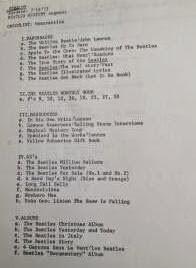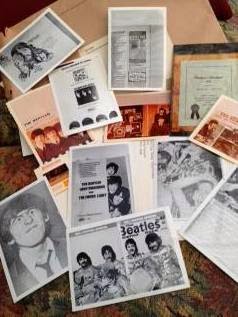 |
| Still from the film |
 |
| Script for the film |
A number of sites on the internet refers to the film as having been nominated for an Academy Award, or even having won one. However, in researching this, I only found that the film was nominated for a "Gold Hugo" award at the Chicago International Film Festival in 1973. One of Braverman's other shorts was eventually nominated for an Academy Award for Documentary Short Subject, that was in 2000, and the documentary, "Curtain Call" didn't win.
"Braverman's Condensed Cream of the Beatles" was distributed in 16mm by Santa Monica based Pyramid Films in the 1970s, but so far has never been officially released for the home video market.
Back in the early eighties when "Beatlefest" used to show actual videos that you couldn't see anywhere else, they would show "Braverman's Condensed Cream of the Beatles" as an annual tradition.
My own encounter with the film was also in the early eighties, when I used to trade video tapes of the Beatles with other collectors. On the video cassette I got, the film had an added monicker, it was called "Time Capsule: Braverman's Condensed Cream of the Beatles". I found it a quirky little film, containing images in sub par quality. Most of the footage used I had in better quality on other tapes. But I guess by then standards were higher than in the early seventies when it was made, and higher quality footage had appeared. The film had a lot of stills, some animation and snippets of films like "A Hard Day's Night", the trailer for "Help!", some Ed Sullivan Show performances and an interview with a bespectacled Sullivan, "The Beatles at Shea Stadium" concert documentary, the promos for "Revolution" and "Strawberry Fields Forever", etcetera, all in far worse shape than the footage I was used to at the time. The most recent footage used in the film was from Harrison's "The Concert for Bangladesh" and Lennon's "One To One" concert, both held at the Madison Square Garden.
 |
| Still from a "A Hard Day's Night" clip used in Braverman's film. |
A full version of the film existed on YouTube, however it has been removed by the powers that be. These days, you can still find the first half of it there, though. The full film has been included on several bootleg DVDs, most notably "Introducing The Beatles" on the (fake) Capitol label and Fab Productions' 2008 release "The Long and Winding Road".
Geraldo Rivera also made liberal use of the film in his various Beatles-related reports in the seventies as well as in his appearance on ABC's Nightline in the early morning hours of Dec. 9, 1980.
There was a "Paul is dead" sequence in this film that got much attention by the conspiration theory people. Here's a discussion about that aspect.
The film pops up occasionally, and is shown at film clubs and 16mm film festivals. For instance, an internet search reveals that it was shown at a 16mm film festival in San Francisco in November, 2010. Some film libraries still have the title. As it is with these old 16mm films, age takes its toll on them, and the colours often get a red hue which gets worse and worse over the years. You can see this on the stills from the film in this very article.
Here's a review of the film from a 1973 edition of The English Journal. The review is of course for the 16mm film, and is likely to have influenced teachers across the USA to screen the then current film in their classrooms.
BRAVERMAN'S CONDENSED CREAM OF BEATLES.
Pyramid Films. 17 minutes, color. Rental: $20 Sale: $250.
Pyramid Films Braverman's newest film, Condensed Cream of Beatles, is a kaleidoscope of flashing images, music and ideas of the rock group who powerfully influenced the youth culture of the sixties. Braverman traces the Beatles' history from their first nervous American appearance on the Ed Sullivan Show, through the next ten years of albums, movies, concerts and personal dilemmas. As a short film, Cream of Beatles is visually more sophisticated than Braverman's Televisionland or The Sixties. While he still uses live television cuts and his "kinestasis" tech-nique in filmmaking, there are a lot of montages created especially to accompany clips from famous songs. There are excerpts from the films A Hard Day's Night, Yellow Submarine, and The Concert For Bangladesh that provide a sense of the philosophical direction of the group. The sense of America's "Beatlemania" infects the viewer in scenes from their famous concert at Shea Stadium. Surprise is registered at that shortlived surge by some to ban the Beatles for their charismatic effect on American youth. Braverman has tied all this together with cuts from songs like "She Loves You" and "Strawberry Fields Forever." There are titles from the Beatle period of political statement—"Revolution," "Song For Bangladesh," (sic) and "We All Shine On." (sic) With every second of film totally infused with speed, color, flashes, zooms and cuts, Braverman has barraged his audience totally with the spirit of the Beatles. Viewing the film is especially individual, for though the Beatles were universally heard, the memories they stir are uniquely one's own. Cream of Beatles has a special meaning for the 20-30 age group who grew up with the Beatles. It is a fascinating return to an important part of one's life. Over a dozen English classes at Masconomet Regional High, representing all types of high school students, have viewed the film. It has evidenced a special success in arousing curiosity among kids about the sixties. Sam Winslow, a 16-year-old student at the high school, has voluntarily seen the film fourteen times. I asked Sam what he would like to say about Cream of Beatles to an audience of high school teachers:
"Many people, like me, only see the Beatles on album covers, or maybe on posters. The Beatles were such an influence on young people, and this movie brings in every aspect that affected the kids. It brings back so many memories of the sixties and early seventies. Charles Braverman is a genius."
Whether or not one can call Braverman a genius, his film does work in the classroom. It can be seriously used as introduction to culture of the sixties, the study of rock music, discussion of the Vietnam War and the Protest Movement. It illustrates the concept of montage in creative writing, and demonstrates both technique and idea in filmmaking. It can be combined with song lyrics printed as poetry, with Braverman's film The Sixties for a study of the recent past, or with other films on Rock and Roll. Unique in conception and style, Cream of Beatles will succeed in the classroom as well as provide genuine entertainment.
Rebecca Fulginiti
Masconomet Regional High School
Topsfield, Massachusetts
It seems to me that Geraldo Rivera commissioned this film from Braverman. To this end, he got in touch with Dave Morrell, who recently (1972) had been in the New York media as a Beatles collector, something unheard of in those days, so soon after the group had broken up.
 |
| Morrell and Furmanek had this card printed |
 |
| Inventory list |
The items they wanted to be in the film was packaged and sent to Hollywood.
 |
| Some of the paper memorabilia that was sent to Braverman. |
Most of the items they supplied were used near the end of the film, accompanied by the song "The Long and Winding Road". When the film was aired on July 30, 1973, Morrell was thanked by Rivera on the air, but Furmanek got no mention and the two are not thanked in the credits of the film. Furthermore, when their memorabilia was shipped back to them, the two friends discovered that some of the items had tape stains etc and were in a worse shape than it was when it had left them.
 |
| The return envelope |
These days, the film is a "relic from a different age", but older fans remember it fondly.
Dave Morrell went on to work in the public relations dept at Warner Bros Records and eventually got to meet all four members of the Beatles, who he has described as "some of the nicest people I have ever met". At 60, he lives in LA and is currently working on a series of easy-to-read books about his life in the music business. The first book, Horse-Doggin', was released in March, and the next installment is due out in September. Morrell supplied us with photos from his archives for this article. You can order his books from his Amazon page here.
Ron Furmanek went on to become an expert on restoring audio and video archives, his work on the Beatles films and promotional videos are evident throughout The Beatles Anthology series. Ironically, a lot of the footage seen in Braverman's film was later restored by Furmanek for Apple Corps Ltd. For more details, see our article on Furmanek's work for the Beatles here.
Charles "Chuck" Braverman continues to make films, and works as an independent producer of television features for many TV companies. His website is here.
Geraldo Rivera hosts the newsmagazine program Geraldo at Large and appears regularly on Fox News Channel. His website is here.





























2 comments:
I saw the film in my 8th grade social studies class - first time I'd seen many of these film clips of the Beatles. It's brevity is what makes it so great - in just a few minutes you take in the radical changes the Beatles went through in under 10 years in the public spotlight and the enormity of their impact on Western culture.
John
http://theglassonionbeatlesjournal.blogspot.com/
In the mid 70's when I was about 12 I discovered the local library loaned out 16mm movies (along with projectors). They had the Braverman film and I remember checking it out several times, watching it over and over in my bedroom. This was well before the advent of home video, so it was a rather thrilling experience.
Post a Comment